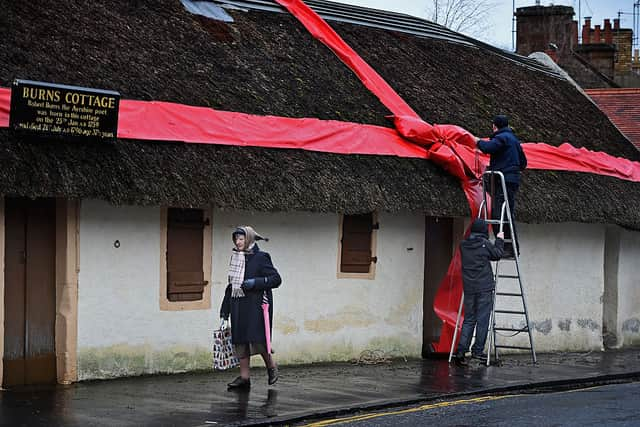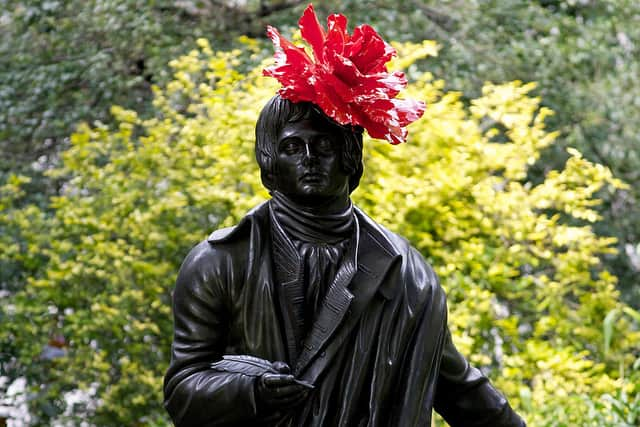Robert Burns facts: who is Scotland’s bard, what poems did he write, did he have kids - and when did he die?
and live on Freeview channel 276
With the end of January on the horizon comes Burn Night, an evening designed to celebrate the life and works of Scotland’s national bard, Robert Burns.
This is everything you need to know about the famous poet.
Who was Robert Burns?
Robert ‘Rabbie’ Burns is a famous Scottish poet, and was known for writing over 550 poems and songs throughout his life.
Advertisement
Hide AdAdvertisement
Hide AdBurns was born in the village of Alloway, near Ayr, to father William and mother Agnes Brown Burnes on 25 January 1759. He was the eldest of seven children.
The house that he was born in was built by his father, and nowadays has been preserved as the Burn Cottage Museum.


He lived there until he was seven years old, when his father sold the house and the family moved to Mount Oliphant farm.
While Burns was a practising poet throughout his life, he was initially a tenant farmer like his father.
Advertisement
Hide AdAdvertisement
Hide AdHe worked on the farm of Mossgiel, where his family moved. Just before turning 29, Burns pursued a career change, gaining employment as an exciseman (or gauger) in Dumfries.
An exciseman was employed by the Government to ensure that people paid their taxes - especially in relation to alcohol.
Was he married - and did he have children?
Throughout his life, Burns had many relationships and children with a variety of different women. The poet fathered 12 children by four different mothers.
His first child, Elizabeth ‘Bess’ Burns, was born in May 1785 by Elizabeth Paton who was his mother’s servant.
Advertisement
Hide AdAdvertisement
Hide AdBy the time his first child had been born, Burns had begun a relationship with Jean Armour and by the end of that year, Jean was pregnant with his second child. Burns and Jean had an on again off again relationship with each other.
It wouldn’t be until 1788 that the two would marry, after their second child together (and Burns’ third overall). Jean and Burns would go on to have nine children together. Of all the children that they had together, only three survived their infancy.


It’s also believed that Jean took care of one of Burns’ illegitimate children following the death of her biological mother, Ann Park.
Jenny Clow, a maid for Mrs Anges Maclehose, had one of Burns’ children in 1788, and in 1790 he welcomed another child out of wedlock with a barmaid in Dumfries.
Advertisement
Hide AdAdvertisement
Hide AdHe then went on to fall in love with Mary Campbell - but unlike his other relationships, the two would not actually have any children together.
At the time of his death, Burns was back together with Jean. She gave birth to his last child, Maxwell, on the same day that he died.
When did he die?
Burns died on 21 July 1796, although the exact circumstances and cause of his death has been subject to speculation.


The most well known theory for his passing is that he died from rheumatism, having been found by the road in the freezing cold rain following a heavy drinking session. Burns held a reputation as a hard drinker, which makes this theory the most popular.
Advertisement
Hide AdAdvertisement
Hide AdHowever, Burns had been seriously ill for a long time - at least five years before his passing.
What poems is he famous for?
Burns penned hundreds and hundreds of poems throughout his lifetime, and many of them would go on to become famous worldwide.
Auld Lang Syne, perhaps the best known of his work, is said to have been adapted by Burns from an old Scottish folk song. It’s traditionally sung at the stroke of midnight at the end of the year, as well as also at funerals, graduations and as a farewell or ending for other occasions.
His poem Tam O’ Shanter tells the story of Tam, a farmer who gets drunk with his friends and acts in a thoughtless way, especially towards his wife.
Advertisement
Hide AdAdvertisement
Hide AdOn the way home one night, Tam sees the local haunted church all lit up, with witches dancing and the Devil playing bagpipes. Tam is chased by the devil, but in the end he escapes.


In 1785, Burns wrote To A Mouse, which, according to legend, was inspired when he accidentally destroyed a mouse’s nest whilst ploughing the fields in winter.
In the poem, Burns apologises to the mouse, and he reflects on the difficulties the mouse will face now that it’s nest has been destroyed.
A Red, Red Rose was penned in 1794, when Burns spent his time preserving the traditional songs of Scotland.
Burns wrote Address to a Haggis to celebrate his appreciation for haggis. During Burns Night supper, it’s customary to read an Address to a Haggis before cutting the haggis open.
Comment Guidelines
National World encourages reader discussion on our stories. User feedback, insights and back-and-forth exchanges add a rich layer of context to reporting. Please review our Community Guidelines before commenting.
